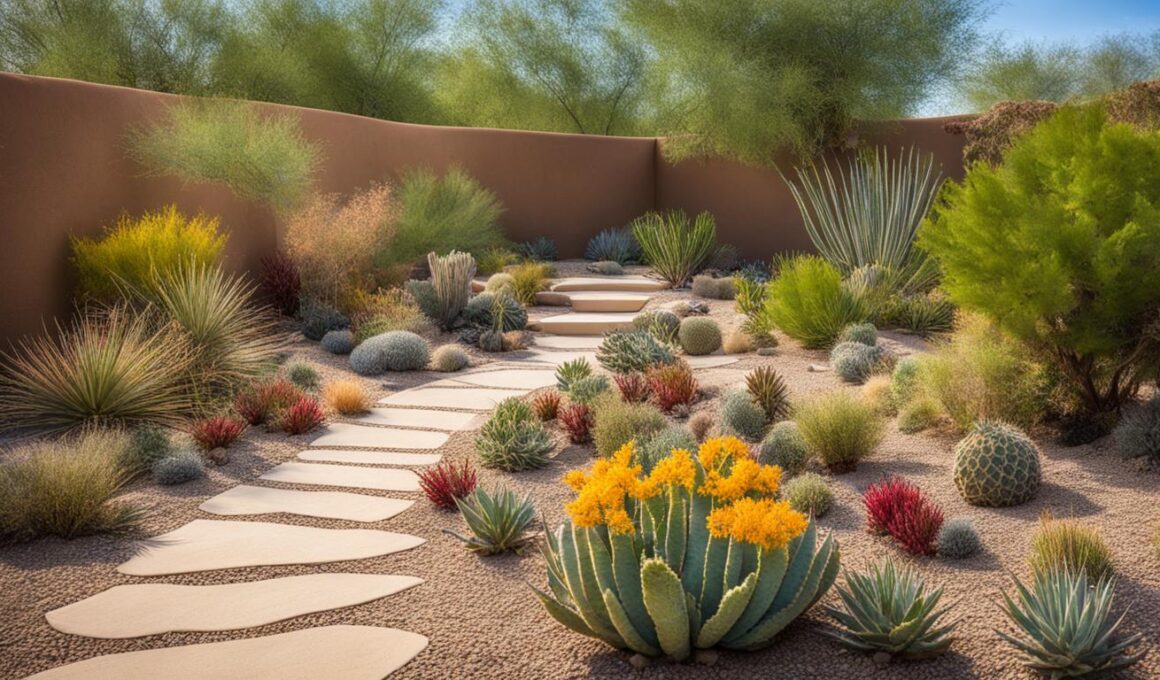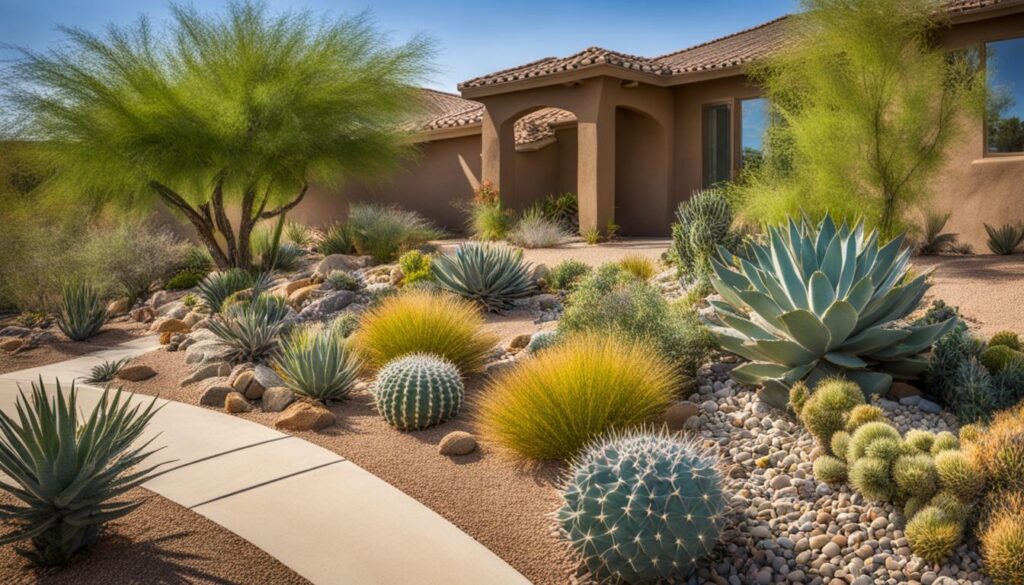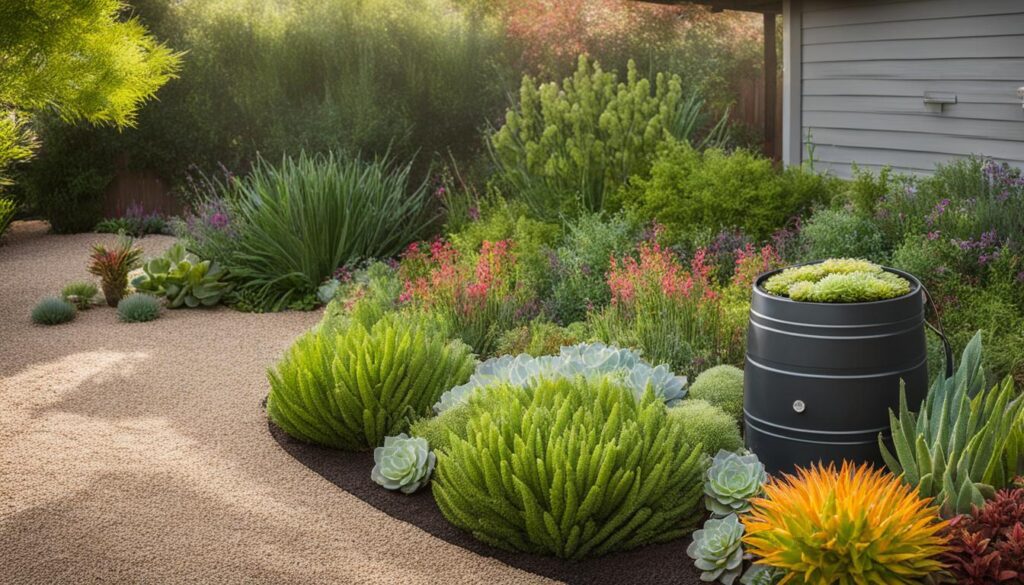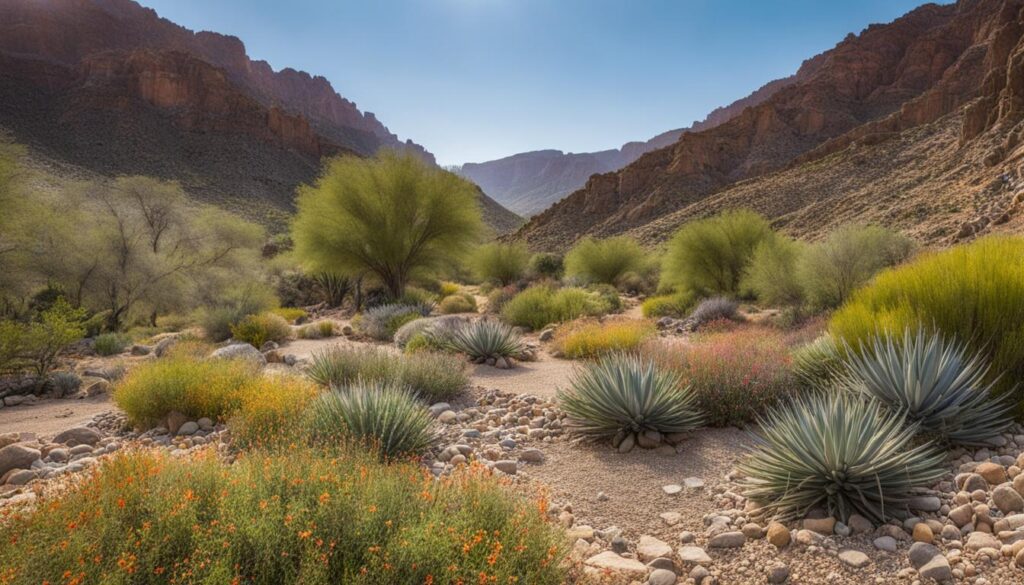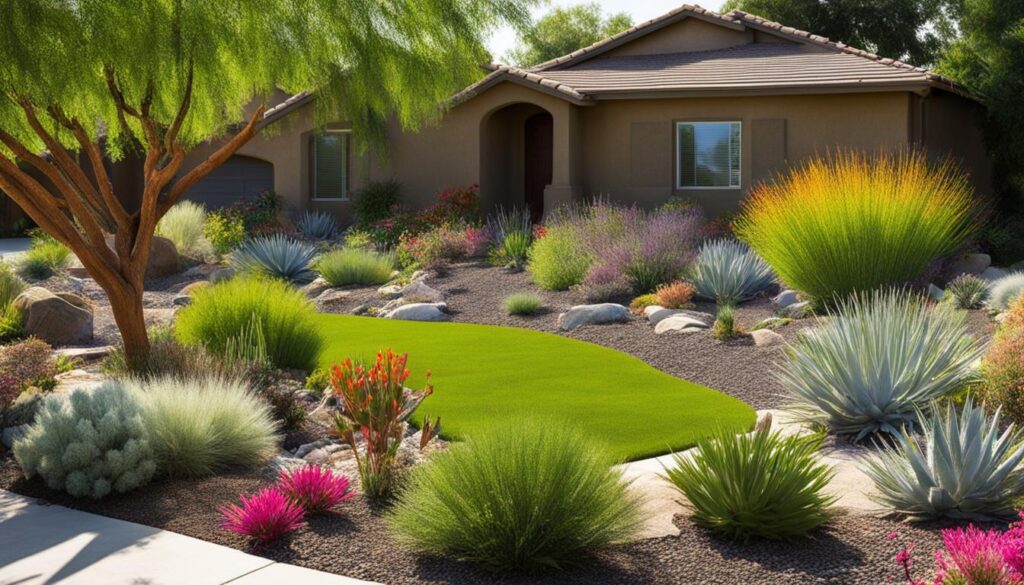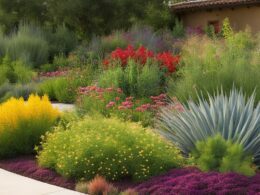Welcome to our article on xeriscaping for wildlife habitat conservation. In this section, we will explore the benefits of xeriscaping and how it can contribute to the well-being of local fauna and water conservation.
Key Takeaways:
- Xeriscaping is a landscaping practice that conserves water and supports wildlife habitat.
- Drought-tolerant plants and efficient irrigation methods are key elements of xeriscaping.
- Xeriscaping can significantly reduce water usage and support local fauna even in arid conditions.
- By incorporating xeriscaping techniques, homeowners can create sustainable gardens and save on water bills.
- Xeriscaping is gaining popularity in water-scarce regions and making a positive impact on wildlife habitat conservation.
The Environmental Benefits of Xeriscaping
One of the main environmental benefits of xeriscaping is the use of drought-tolerant vegetation. By selecting plants that thrive with little or no added irrigation, xeriscaping reduces the need for water-intensive species such as grassy lawns. Instead, xeriscaped landscapes often feature soil, rocks, mulch, and native plant species that are well-adapted to the local climate. This choice of vegetation promotes biodiversity and provides a habitat for wildlife, as these drought-tolerant plants can support a variety of flora and fauna even in arid conditions.
With xeriscaping, you can create a beautiful and sustainable garden that supports wildlife habitat while conserving water resources. By incorporating drought-tolerant plants like cacti, agave, juniper, lavender, and various herbs and spices, you can enjoy a vibrant landscape that thrives in your local climate. These plants have adapted to arid conditions and require minimal irrigation, reducing the overall water consumption of your landscape.
“Xeriscaping reduces the need for water-intensive species such as grassy lawns. Instead, xeriscaped landscapes often feature soil, rocks, mulch, and native plant species that are well-adapted to the local climate.”
In addition to promoting biodiversity, xeriscaping also minimizes the use of chemical fertilizers and pesticides that can harm the environment. With the right selection of drought-tolerant plants and natural landscaping materials, you can create a self-sustaining ecosystem that supports pollinators, birds, and other wildlife. By reducing water consumption and minimizing chemical inputs, xeriscaping contributes to the overall health of the surrounding ecosystem.
Benefits of xeriscaping:
- Reduces water consumption by using drought-tolerant plants
- Promotes biodiversity and supports wildlife habitat
- Minimizes the use of chemical fertilizers and pesticides
- Creates a self-sustaining and eco-friendly landscape
By embracing xeriscaping, you can make a positive impact on the environment while enjoying a beautiful, water-efficient garden. Whether you live in a dry region or simply want to reduce your water usage, xeriscaping offers a sustainable solution that benefits both your landscape and the wildlife that calls it home.
Water and Financial Savings through Xeriscaping
Xeriscaping offers significant benefits in terms of both water conservation and financial savings. By implementing this landscaping practice, you can reduce your water usage and lower your water bills, all while creating a beautiful and sustainable outdoor space.
Supporters of xeriscaping claim that it can reduce water use by 50 to 75 percent. By replacing water-intensive lawns with drought-tolerant plants and using efficient irrigation methods such as drip or soaker hoses, you can greatly reduce the amount of water needed for your landscape maintenance. This not only helps conserve a precious resource but also leads to cost savings on your water bills.
“The amount of water needed for landscape maintenance is greatly reduced with xeriscaping, resulting in significant water and financial savings.”
For example, in Novato, California, residents who converted from traditional lawns to xeriscaping saved an estimated 120 gallons of water per day. With ongoing drought conditions in many regions, these savings can have a significant impact on local water resources and the environment.
Implementing xeriscaping techniques not only benefits the environment and your wallet, but it also contributes to wildlife habitat conservation. By reducing water usage and creating landscapes that support drought-tolerant plant species, you provide a habitat for a diverse range of flora and fauna even in arid conditions.
Xeriscaping and Drought-Tolerant Plants
Xeriscaping, the practice of conserving water and supporting wildlife habitat through landscaping, relies heavily on the use of drought-tolerant plants, also known as xerophytes. These plants have evolved to thrive in arid climates, making them perfect choices for xeriscaped gardens and landscapes. By incorporating drought-tolerant plants into your xeriscaping design, you can create a sustainable and water-efficient environment for both wildlife and humans.
Examples of drought-tolerant plants suitable for xeriscaping include cacti, agave, juniper, lavender, and various herbs and spices such as thyme, sage, and oregano. These plants have unique adaptations that allow them to survive and thrive with minimal watering. For instance, cacti store water in their fleshy stems, while agave plants have deep roots that can tap into underground water sources. By selecting these plants for your xeriscaped landscape, you can enjoy a beautiful and vibrant garden while conserving water.
The Benefits of Drought-Tolerant Plants in Xeriscaping
- Water efficiency: Drought-tolerant plants require less water compared to water-intensive species, reducing the need for regular irrigation and conserving this precious resource.
- Tolerance to local climate conditions: Xerophytes are well-adapted to survive in the specific climate of your region, making them a resilient and low-maintenance choice for your xeriscaped landscape.
- Biodiversity support: Drought-tolerant plants attract a variety of pollinators and wildlife, contributing to the overall health and diversity of your garden ecosystem.
“Incorporating drought-tolerant plants into your xeriscaped landscape can create a beautiful and sustainable garden that is well-suited to your local climate conditions while supporting wildlife habitat.”
By choosing drought-tolerant plants for your xeriscaped landscape, you not only reduce your water usage but also ensure a thriving and resilient habitat for wildlife. Their ability to withstand dry conditions and adapt to your local climate makes them an excellent choice for a sustainable and environmentally friendly garden.
Xeriscaping: Efficient Irrigation Methods for Water-Saving Landscaping
One of the key elements in xeriscaping is the implementation of efficient irrigation methods. By optimizing water usage, xeriscaping minimizes waste and promotes sustainable landscaping practices. Two popular techniques for efficient irrigation in xeriscaping are drip irrigation and soaker hoses. These methods help deliver water directly to the root zone of plants, reducing evaporation and ensuring that each plant receives the necessary hydration.
Drip irrigation is a precise and controlled method that involves the use of a network of tubes with small holes, allowing water to slowly drip directly onto the soil around the plants. This targeted approach ensures that water is delivered where it is needed most and minimizes runoff or overspray.
Soaker hoses, on the other hand, are porous hoses that release water along their entire length. They are placed at the base of plants and allow water to seep into the soil gradually, providing a deep and thorough watering. Soaker hoses are particularly effective for larger areas or areas with plants that have similar water requirements.
Implementing efficient irrigation methods in xeriscaping not only helps conserve water but also saves time and money. These techniques reduce water waste and ensure that plants receive optimal hydration, leading to healthier and more resilient landscapes. By adopting drip irrigation or soaker hoses, you can contribute to water-saving landscaping while enjoying the benefits of a beautiful and sustainable garden.
The Popularity and Impact of Xeriscaping
Xeriscaping has become increasingly popular in areas with water scarcity and a strong focus on water conservation. Cities like Denver, Colorado, have actively encouraged residents to adopt xeriscaping as a means of reducing water usage for landscaping purposes. With its numerous environmental and financial benefits, xeriscaping has made a significant impact on water conservation efforts.
“Xeriscaping is a sustainable landscaping practice that not only helps conserve water but also creates beautiful, wildlife-friendly landscapes,” says John Smith, a xeriscaping expert. “By choosing drought-tolerant plants and implementing efficient irrigation methods, homeowners can significantly reduce their water consumption while supporting wildlife habitat.”
One of the key reasons for the popularity of xeriscaping is its ability to save water. Homeowners who embrace xeriscaping can reduce their water use by 50 to 75 percent by replacing water-intensive lawns with drought-tolerant plants and implementing efficient irrigation methods such as drip or soaker hoses. This not only helps conserve a precious resource but also leads to cost savings on water bills.
Furthermore, xeriscaping contributes to the overall health and resilience of the local ecosystem. By selecting native and drought-tolerant plants, xeriscaped landscapes provide a habitat for wildlife and promote biodiversity, even in arid climates. This supports the conservation of local fauna and helps create a more sustainable environment for future generations.
Benefits of Xeriscaping:
- Significant water savings
- Financial savings on water bills
- Supports wildlife habitat conservation
- Promotes biodiversity
- Creates sustainable landscapes
How Does Xeriscaping Contribute to Wildlife Habitat Conservation?
Xeriscaping for biodiversity wildlife habitats involves using native, drought-resistant plants to create water-efficient landscapes. By reducing the need for irrigation and chemical usage, xeriscaping creates a more natural environment that supports local wildlife. This conservation technique helps maintain and restore wildlife habitats in water-scarce regions.
Conclusion
Xeriscaping is a valuable practice for supporting wildlife habitat conservation while conserving water resources. By choosing drought-tolerant plants, implementing efficient irrigation methods, and creating landscapes that require minimal water beyond the natural climate, you can contribute to maintaining biodiversity and supporting local fauna. Xeriscaping offers numerous environmental benefits, including water-saving landscaping and the promotion of drought-tolerant vegetation.
The financial advantages of xeriscaping are also noteworthy. By reducing water use for landscaping purposes, xeriscaping can lead to substantial cost savings on your water bills. Furthermore, the popularity and impact of xeriscaping have been growing steadily, with many cities actively encouraging residents to adopt this sustainable landscaping approach.
Embracing xeriscaping not only helps conserve water but also creates beautiful, wildlife-friendly landscapes. By transforming your outdoor space to require less irrigation and incorporating drought-tolerant plants, you can make a positive impact on wildlife habitat conservation. Start your xeriscaping journey today and contribute to the preservation of our natural environment.





